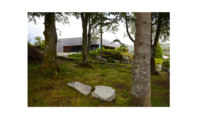Rick Sawdey got the last laugh.
As a child, Sawdey would occasionally lose his beloved BB gun when his dad wanted to punish him for shooting out barn windows on the family farm in Michigan. Now, not only is Sawdey encouraged to try to break windows, he gets paid for it by MI Windows and Doors.
Recruited by MI more than a decade ago, Sawdey is the Test Lab Manager at the company’s engineering and innovation facility in Gratz, Pa., overseeing the diagnostic procedures on one of the largest testing walls in the industry.
“When we first moved to our larger lab in 2008, the first product we tested was a 20-foot-by-10-foot patio door,” Sawdey says. “It was very interesting: I’d never tested anything that large in a residential-type test. It was something new for all of us here.”
That was nearly 10 years ago, and the testing lab has since continued to evolve with the newest computer-control systems and pressure equipment.
“We installed the latest technology in testing controls,” says Ray Garries, MI’s Vice President of Engineering and Innovation. “This new technology can be monitored from our computer network, while easily managing even the most difficult tests, including stringent hurricane-testing protocols. We also test research units, components and sizes to ensure we develop the very best products for consumers.”
It’s a long way from where the test lab was when Sawdey first arrived in 2007. The conditions weren’t what he’d been used to as a window tester at CertainTeed in Indianapolis.
“It was a really tiny area,” Sawdey says of the old MI lab, which was located in a building formerly used for window screening. “We had to install windows in the bucks out in the parking lot, and then pull them into the lab for testing. There just wasn’t enough room to do it all in one place.”
A year later, following the renovation of the building next door to MI’s customer support center, the new testing lab was born. Now, Sawdey and his team use the expanded space and wall for a plethora of tests, including standard air, water, and structural testing.
“We do hardware, load, forced-entry, deglazing, air leakage, and water penetration testing– anything associated with certifying a window for air, water, structural use,” Sawdey says. “For load testing, design pressure is applied on the window. The structural load test then applies one and a half times that amount of pressure. So, basically, you’re putting pressure on the window in the same way that wind blows on a house. It takes both positive design pressure on the structural load and negative design pressure to rate windows.”
Design pressure gives a fenestration product a rating largely based on wind resistance. But windows are also given a performance grade, which measures the other factors that Sawdey mentions, like water-penetration and forced-entry resistance. Performance grades are then determined by how well a window achieves the specifications demanded by the North American Fenestration Standard.
The demand for impact-rated, hurricane-proof products is one of the biggest changes to window testing since Sawdey started in the profession nearly two decades ago.
“The weather, with hurricanes and the like, is forcing building codes to be reevaluated with stricter codes being put into place,” Sawdey says. “They might say, ‘Hey, we don’t meet these wind pressure demands here because of the terrain.’ It’s constantly evolving and changing. The residential building codes help drive that. We started doing a lot more impact and cycle testing to make sure our products meet the required specifications for certain storm-prone areas.”
As a result, certification requirements continue to evolve with the next code cycle scheduled for release in 2019.
“More changes are coming,” Sawdey says. “You know they’re inevitable. The big thing on the West Coast is fire testing. We don’t have a fire-rated product – I see that changing. In the East, some of the more severe weather and hurricanes are also going to force changes. You know it’s coming; it’s just about the next phase of implementation.”
MI is ready. In addition to the new computerized testing controls, Garries and Sawdey are excited for the new component testing lab that is under construction in the company’s engineering and innovation building.
“This facility will test all our components for durability, compatibility, and weathering,” Garries says. “It will also help us select the components best suited for keeping our windows and doors operating long term. Part of this lab will test the seals in our insulated glass units (IGU’s). By severe testing our IGU’s, we will be able to pinpoint the details that make the sealed space perform better for longer period of times.”
Although the testing procedures for the fenestration industry get more and more complex, Sawdey loves the challenge of it all.
“It’s fun to see if brand-new products perform the way they did on paper. The process starts with the testing of prototypes on the wall and then proceeds with the input of product designers and engineers. That’s how it all comes together and you get a finished product that meets stringent testing standards,” adds Sawdey.
The testing protocols may keep changing, but the appeal of the test lab for tour groups will remain the same: watching a 2x4 get shot out of a cannon. It’s a sight that never disappoints.
Just ask Sawdey. He gives tours every week. Sometimes the groups are members of MI’s own sales force, sometimes they’re customers, and sometimes they’re engineering students or simply kids from local school districts. Regardless of who they are or where they’re from, they all get saucer eyes when Sawdey fires the 2x4 – traveling at 35 miles per hour – at the wall. In fact, Sawdey’s own son was extremely excited to see the action.
“We let him shoot the cannon one day,” Sawdey says. “He said, ‘Ohhh, that was neat!’”









